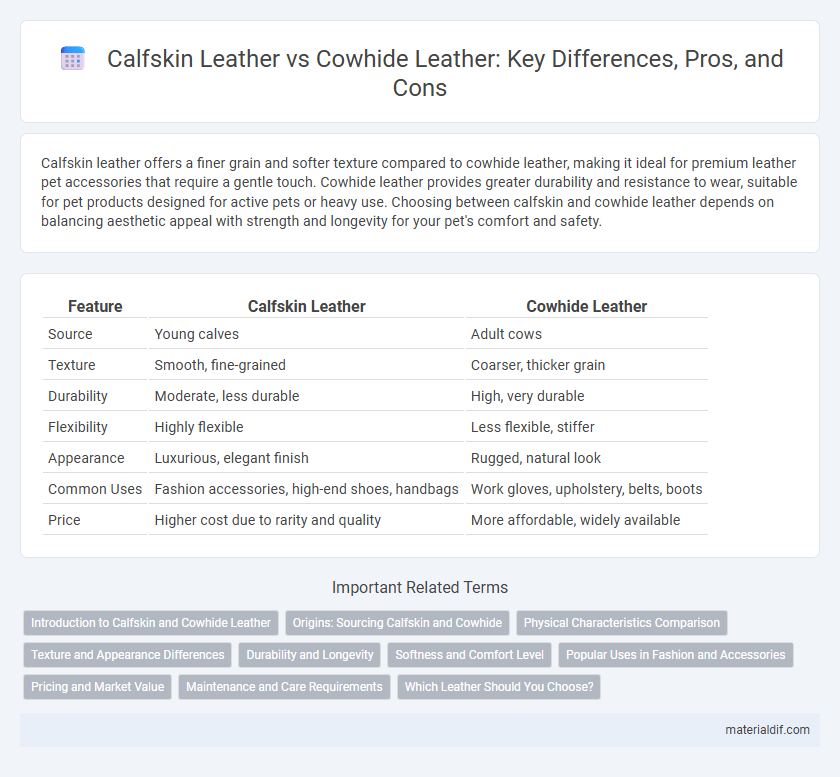Calfskin leather offers a finer grain and softer texture compared to cowhide leather, making it ideal for premium leather pet accessories that require a gentle touch. Cowhide leather provides greater durability and resistance to wear, suitable for pet products designed for active pets or heavy use. Choosing between calfskin and cowhide leather depends on balancing aesthetic appeal with strength and longevity for your pet's comfort and safety.
Table of Comparison
| Feature | Calfskin Leather | Cowhide Leather |
|---|---|---|
| Source | Young calves | Adult cows |
| Texture | Smooth, fine-grained | Coarser, thicker grain |
| Durability | Moderate, less durable | High, very durable |
| Flexibility | Highly flexible | Less flexible, stiffer |
| Appearance | Luxurious, elegant finish | Rugged, natural look |
| Common Uses | Fashion accessories, high-end shoes, handbags | Work gloves, upholstery, belts, boots |
| Price | Higher cost due to rarity and quality | More affordable, widely available |
Introduction to Calfskin and Cowhide Leather
Calfskin leather, derived from young calves, is renowned for its fine grain, smooth texture, and superior softness, making it ideal for luxury goods and high-end fashion items. Cowhide leather, obtained from mature cows, offers greater durability and a coarser texture, commonly used in heavy-duty products like jackets, boots, and furniture. Understanding the distinct characteristics of calfskin and cowhide leather helps in selecting the right material based on durability, appearance, and intended use.
Origins: Sourcing Calfskin and Cowhide
Calfskin leather is sourced from young calves, typically less than six months old, resulting in a finer grain and smoother texture ideal for luxury goods. Cowhide leather comes from mature cows, offering a thicker, more durable material commonly used for heavy-duty products like boots and furniture. The distinct origins influence the leather's softness, strength, and price, with calfskin often preferred for premium fashion items due to its delicate nature.
Physical Characteristics Comparison
Calfskin leather is finer-grained, smoother, and softer compared to cowhide leather, which is thicker and more durable with a coarser texture. The tight grain structure of calfskin results in a supple feel and a more refined appearance, making it ideal for luxury goods. Cowhide's robustness offers superior resistance to wear and tear, suitable for heavy-duty applications like upholstery and workwear.
Texture and Appearance Differences
Calfskin leather features a finer, smoother texture with a silky appearance due to the younger age of the animal, providing a more delicate and supple feel. Cowhide leather is coarser with a more pronounced grain pattern, offering greater durability and a rugged, natural look. The differences in texture and appearance significantly influence the choice between calfskin's luxury aesthetic and cowhide's robust practicality.
Durability and Longevity
Calfskin leather is finer and more supple, offering a softer texture but generally less durability compared to cowhide leather, which is thicker and more robust. Cowhide leather excels in longevity due to its dense fiber structure, making it ideal for products that endure heavy use and wear over time. While calfskin provides luxurious aesthetics, cowhide's superior toughness ensures extended lifespan in leather goods.
Softness and Comfort Level
Calfskin leather offers superior softness and a smoother texture compared to cowhide leather, making it highly prized for comfort in luxury goods. Its finer grain and lighter weight contribute to a more supple feel, enhancing wearability and flexibility. Cowhide leather, while more durable and rugged, tends to be thicker and stiffer, which may compromise comfort but provides increased resistance to wear and tear.
Popular Uses in Fashion and Accessories
Calfskin leather is prized for its smooth texture and fine grain, making it a popular choice for luxury fashion items like high-end handbags, shoes, and belts. Cowhide leather, known for its durability and toughness, is widely used in more rugged accessories such as wallets, jackets, and boots. Both materials serve distinct roles in fashion, with calfskin favored for elegance and cowhide for long-lasting wear.
Pricing and Market Value
Calfskin leather generally commands a higher price and market value compared to cowhide leather due to its finer grain, superior softness, and limited supply from younger animals. Cowhide leather, while more abundant and durable, is typically more affordable and preferred for products requiring longevity and ruggedness. Market demand for calfskin often targets luxury goods, driving its premium pricing relative to the more utilitarian cowhide.
Maintenance and Care Requirements
Calfskin leather requires more delicate maintenance due to its finer grain and softer texture, making it susceptible to scratches and stains, so regular conditioning with specialized leather care products is essential. Cowhide leather, being thicker and more durable, tolerates more rigorous cleaning methods and less frequent conditioning, yet it still needs proper moisture control to prevent cracking and maintain suppleness. Both types benefit from avoiding prolonged exposure to direct sunlight and humidity, which can deteriorate leather fibers and alter color.
Which Leather Should You Choose?
Calfskin leather offers a soft, smooth texture and superior durability, making it ideal for high-end fashion accessories like wallets and shoes that require a refined appearance. Cowhide leather is thicker and more robust, providing excellent resistance to wear and tear, which suits heavy-use items such as belts, jackets, and upholstery. Choosing between calfskin and cowhide depends on the desired balance between elegance and durability, as well as the specific application of the leather product.
Calfskin Leather vs Cowhide Leather Infographic

 materialdif.com
materialdif.com